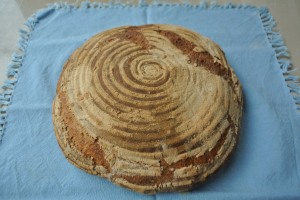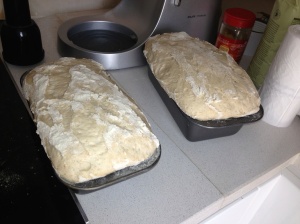 A fact you may not know about Saudi Arabia is good bread is very hard to come by here. Delicious and varied types of Flat bread are available, but properly fermented, boutique bakery style breads are not available apart from in a very few speciality stores in the centre of Riyadh and once a month at The German Bakery stall at Kingdom Compound Coffee Morning which I can’t be bothered to queue for. The supermarkets sell the usual or worse than usual sliced white, full of sugar, and of a plastic texture. The brown bread is similar but coloured brown with caramel. You start to get worried when it lasts forever and seems to be full of preservatives. And as Julia Child once said (of America) “How can a nation be great when its bread tastes of Kleenex”. I can tell you I’ve eaten a lot of kleenex over the years.
A fact you may not know about Saudi Arabia is good bread is very hard to come by here. Delicious and varied types of Flat bread are available, but properly fermented, boutique bakery style breads are not available apart from in a very few speciality stores in the centre of Riyadh and once a month at The German Bakery stall at Kingdom Compound Coffee Morning which I can’t be bothered to queue for. The supermarkets sell the usual or worse than usual sliced white, full of sugar, and of a plastic texture. The brown bread is similar but coloured brown with caramel. You start to get worried when it lasts forever and seems to be full of preservatives. And as Julia Child once said (of America) “How can a nation be great when its bread tastes of Kleenex”. I can tell you I’ve eaten a lot of kleenex over the years.
After a couple of months, I became so fed up with Kleenex bread that I decided to try and make my own Sourdough Bread. I had little experience of bread making, apart from the odd quick yeast loaf and Pizza dough. I don’t consider myself to be one of those keen baking types but my yearning for really good bread and butter was so great that I was prepared to have a go.
Sourdough bread has sort of mystery about it. It is a confection of wild yeasts, flour and water, simple ingredients you may think, its production is shrouded in hidden secrets and passed down concoctions. In fact, before the nineteenth century almost all bread was made with passed down pre-fermented cultures. Commercial bakers used cultures from breweries and their own local handed down “preferments”. In France and Italy today, these cultures are closely guarded, and some, are boasted by their owners, to date back to the 16th Century. The famous San Francisco Sourdough bread culture dates back to 1849. But when it comes to making some yourself, everywhere you read recipes, large letters are printed “do not try this if you are a beginner”. That for me is red rag to a bull. Sourdough bread is made from a natural yeast culture that you capture from the natural yeasts on fruit, in flour and in the air around us. What could go wrong? I thought that maybe I would be lucky and be able to encourage local yeasts to make “mi casa su casa”.
My first attempt at a sourdough culture was an abject failure! I had been attracted to the bright lights and blue eyes of the “Great British Bake-off” presenter, Paul Hollywood and decided to try his recipe. It is published on the BBC website. After following the instructions precisely for several weeks, I tried to make bread, again according to his instructions. It was disgusting. I am sorry I didn’t take a photo of the result, but the loaf, if you can call it that, had to go straight in the trash can.
I felt despondent after all the effort I had expended, but then decided that I would have one more attempt but using a different recipe for the sourdough starter. This time I used a recipe from the Moro Cookbook. I followed those instructions almost exactly, although, I did add some Rye flour, as apparently more wild yeasts grow on Rye. After a number of days the rather rank mixture looked decidedly dead! However, as I perceived a few bubbles, I continued with the twice daily feeding process. After a couple of weeks, I was seriously thinking of murder by drain as it was disgusting, but decided that I would have a now or never attempt at baking a loaf using the unpromising looking mixture.
So I made the loaves according to Sam Clarke’s recipe, I had little hope of this working out, but almost unbelievably the starter worked and the dough rose. I was childishly excited by this.
 The next trial, was would they bake without collapsing and be edible. They came out of the oven perfectly. The DH can attest to their deliciousness.
The next trial, was would they bake without collapsing and be edible. They came out of the oven perfectly. The DH can attest to their deliciousness.
When you have a starter culture that works you can keep it in the fridge and feed it once a week. You can even freeze it successfully if you are going away. I have discovered since I started baking this type of bread that it is not very good for waistlines, and although my bread is not quite of a professional standard, I and all my family and friends seem pleased with the results.
The bread making process for this type of bread takes between 12 and 15 hours in two parts. The first rise takes between 8 & 12 hours and second rise between 3 & 5 hours. I do the first stage over night and start the second next morning to have baked bread by Mid-day. The times depend on the mood of the starter and the room temperature. It is different every time. The dough for this type of bread is wet and difficult to handle, so if you want to make round loaves, you have to have a banneton, which is a proving basket. It is easier to make in tins, but I have been successful with bannetons by adding just a little more flour to the dough. You can order bannetons online, but any whicker basket would work with a well floured linen lining. It is also much better to bake it on a Pizza Stone if you have one.
I have also learnt a great deal more about doughs in general and am branching out into other bakery items, such as rolls and fermented cake doughs. I think croissants will be a step too far as I might eat too many and become a Pilsbury dough boy.
I am not sure if I will continue to bake this bread when I leave the Kingdom as making it is a lifestyle choice, and I know I can easily buy bread as good or better than mine for no effort in Europe or the USA. But while I am here, I challenge anyone to bring me a better loaf.
Follow the link to find the recipe page and web-sites that helped me.


Sound as though you’ve had a lot of fun, and gastronomic satisfaction…but I think I’ll stick to my current recipe with freeze dried yeast!!
>